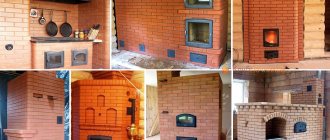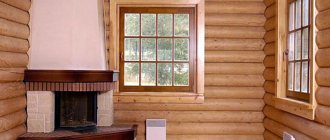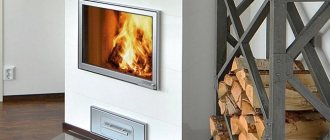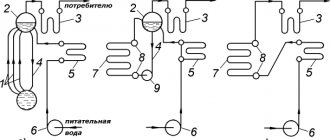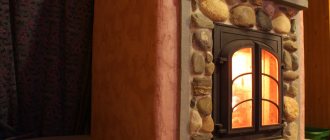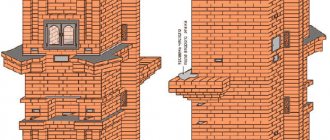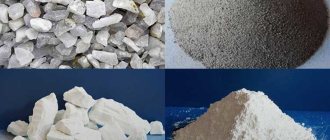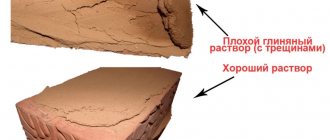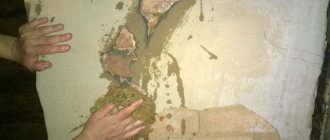How to choose cement for mixing oven mortar?
Cement mortar, as a particularly strong binding material, consists of cement, filler (sand) and water. In terms of the construction of heating furnaces, cement mortar is used for laying foundations in damp soils or soils saturated with moisture. It can also be used for the construction of chimneys and hogs, which are not affected by the high temperature of furnace gases.
At the same time, the proportional composition of the components should ensure high strength of the building structure. Therefore, the composition of the tub mortar for laying a furnace can be described as “strong” - 1 part M400 cement and 1 part sifted sand.
There is no point in changing the proportions in the direction of reducing the amount of cement, because in this case there is a danger of encountering low durability and the need for expensive repairs.
Cement for masonry stoves is used to prepare so-called complex mortars consisting of M400 cement, lime milk and sifted sand. In this case, for one part of cement, take 1-3 parts of lime paste and six parts of sifted sand. This recipe is suitable for use in the construction of foundations and furnace elements that do not experience high temperature loads (chimneys, chimney hoods and foundations).
Materials for stoves and fireplaces
When building almost any country house, people are faced with the choice of materials for the construction of stoves and fireplaces.
Even if a modern gas boiler is used, and a fireplace is not planned, you should think about chimneys of a new generation, and not the day before yesterday. Let’s start, as they say, “from the stove.” To build a stove or fireplace, you need either a project or a talented stove maker.
Now to the materials. To build a stove or fireplace, fireproof (fireclay) brick is required, and it is used only for the firebox, where the brick comes into contact with the flame. For a medium-sized firebox you need from 50 to 100 fireclay bricks.
These bricks must be connected to each other using a special fire-resistant mortar or oven masonry mixture. Such mixtures can withstand temperatures up to 1200 degrees. Sometimes they use refractory clay powder, adding sand and water to it “to taste.”
The main part of the stove or fireplace is made of high-quality solid bricks. They are connected to each other using a kiln masonry mixture or cement-sand mortar. An interesting option for mortar for masonry stoves is a mixture of clay with tennisite (ground brick chips) - tennisite, unlike sand usually included in the masonry mixture, has a coefficient of thermal expansion that coincides with the coefficient for clay, which avoids thermal stresses in the joints.
Hereditary stove makers have the habit of checking the heat capacity of the bricks they plan to use in masonry. Buckets of water are placed on heated bricks from different manufacturers, and after some time the water temperature is checked. For a good stove, the brick must have a high heat capacity. It has been experimentally established that the higher the grade of brick, the greater its density and, accordingly, the heat capacity. Therefore, preference when laying a furnace is given to high-quality solid bricks.
Slit (or effective) brick is not used when laying a stove; it can be used for a fireplace, and then only if the fireplace serves an exclusively decorative role. This is due to the fact that the air voids in the slotted brick are heat insulators, sharply reducing the heat transfer from the stove. There are many shaped bricks (not only slotted, but also solid) that allow you to lay out unusual shapes of stoves and fireplaces (with arches, curves, bevels, mantelpiece, etc.).
The outer surface of the stove can be plastered, whitewashed (antique), covered with tiles or made of beautiful front solid brick. The fireplace can be brick, covered with brick-like ceramic tiles (i.e. very thin bricks) or have a portal made of marble.
Fireplaces and stoves made from hand-molded solid bricks look very unusual and impressive. The colors of these bricks usually vary, but go well together. This imitates ancient masonry. You can also use bricks with stamps in masonry as a decorative element (these can be old factory stamps, the initials of the owner, the year the house was built or the coat of arms of Russia - in short, whatever your heart desires).
If the outer part of a brick fireplace or stove is placed on a cement-sand mortar, and not on clay, we can advise you to get very original options using masonry mixtures not of the usual gray color, but of other colors (white, sand, orange, brown, etc.). d.).
Separately, it is necessary to say about products made of cast iron or, as stove makers call them in their slang, “cast iron”. Almost always, these products are used when laying stoves and fireplaces. This could be a firebox, a door for the stove, for blowing, a container for collecting ash, etc. and so on. Stove makers prefer Finnish cast iron products.
Chimney systems. Everyone remembers the brick chimneys that have been built in all countries from time immemorial, as well as the medieval profession of a chimney sweep. In Soviet times, asbestos-cement pipes wrapped in insulation were often used as chimneys. Richer people made their own chimney from a stainless pipe.
And now a little theory. Flue gases have a high temperature and contain combustion products - water vapor and acid vapors. The outer side of the pipe is in cold air, therefore, a large temperature difference occurs. When heated by flue gases, the pipe expands both in height and width, temperature stresses arise, which subsequently lead to the destruction of the brick chimney. In the upper part of the pipe, due to cooling, condensation of water and acid vapors appears, which flows down. The resulting acid and water react with the cement holding the bricks of the pipe together, with the bricks themselves, with the stainless steel and, especially, with the asbestos-cement pipe. As a result, all materials in traditional chimneys are destroyed. The square cross-section of a brick pipe creates turbulence in the corners, making it difficult to remove flue gases; soot accumulates in the corners, which is difficult to remove even for a professional chimney sweep and which can subsequently catch fire. When soot ignites, the temperature in the pipe reaches 1000 degrees, the expansion of the pipe increases significantly, and the brick chimney is destroyed.
Modern ceramic chimneys do not have all these disadvantages. The heart of such a chimney system is a round ceramic pipe made of pure fireclay clay. This pipe is protected by mineral wool insulation. The outer layer may vary depending on at what stage of construction the chimney is installed.
The most optimal in terms of price-quality ratio and installation speed is a chimney enclosed in a shell of expanded clay concrete blocks. It can be installed in any desired location during the construction of a house. If it is too late and there is nowhere to place a chimney made of blocks, use a chimney with an outer casing made of stainless steel. And, if it is already too late and we are talking about modernizing an old brick chimney, you can place a new ceramic pipe inside the old shaft. You can see the advantages of using modern chimney systems over old ones here.
Heat-resistant cement mixtures
Heat-resistant cement mixtures are used for the construction of monolithic open flames (furnaces) or blocks for laying stoves and their fireboxes. In this case, you should adhere to the following requirements for the composition of components from experienced stove builders:
| Components of masonry mortar | Quantity in proportions |
| Cement grade M400-M50 | 1 |
| Crushed red brick | 2-2,5 |
| Fireclay sand | 0,35 |
| Sand | 2-2,4 |
Heat-resistant cement mixtures for fireboxes
| Components of masonry mortar | Quantity in proportions |
| Cement M40-M500 | 1 |
| Crushed red brick | 2 |
| Sand | 2 |
| Fine sand | 0,35 |
Experts in laying stoves and fireplaces, based on extensive practical experience, strongly do not recommend using cement in the construction of stoves and fireplaces. This is a fairly expensive material, which with success and a 100% guarantee, all other things being equal, is replaced by cheap and widely available yellow or red clay.
Furnace mortar based on red clay 40 kg MASTER
A stove solution based on pure red clay, sifted sand and purified water. The solution is prepared mechanically using a special technology and has properties that cannot be obtained with the traditional, manual method of production. Furnace solution is used for all types of furnace work. It is characterized by increased ductility, high fire resistance and improved aesthetic qualities. To preserve the plasticity of the clay, the stove mortar is prepared in a semi-dry form. It is used for laying stoves, fireplaces, as well as for laying bricks around the stove and chimney. Red clay mortar is identical in nature to refractory bricks, which avoids cracks in the seams and bricks falling out. The homogeneity of mixtures of red clay and refractory bricks makes the seams invisible, weight 40 kg, in a bag. Stove mortar based on pure red clay is used for laying and repairing household stoves and fireplaces, barbecues, barbecues, hearths, various types of pipes, lining bathhouses and household metal stoves with bricks, coating stoves, etc.
The stove solution is prepared using ordinary pure red clay, sifted sand and purified water. The solution is prepared mechanically using a special technology and has properties that cannot be obtained with the traditional, manual method of production. Furnace solution is used for all types of furnace work. It is characterized by increased ductility, high fire resistance and improved aesthetic qualities. To preserve the plasticity of the clay, the oven solution is prepared in a semi-dry form. Semi-dry oven solution is packaged in 40 kg bags.
Before use, the semi-dry solution must be diluted with water to obtain the desired consistency and mixed. There is no need to soak the solution! The consistency of the finished solution is like thick sour cream. When laying and repairing fireboxes (furnaces) and the first flues of stoves and fireplaces, it is necessary to use fire-resistant bricks and special fire-resistant fireclay mortars - mortars.
APPLICATION OF OVEN SOLUTION. The baking solution is supplied in bags in semi-dry form. After opening the bag, add water to the solution and mix thoroughly by hand, trowel or drill with a mixer. To obtain a more liquid solution, add water (tap, well, rain) and mix. To obtain a thicker consistency of the solution, leave it in the open air for 3-5 hours or add sand (no more than 1/10 of the volume). The dried solution is suitable for repeated reuse after adding water and mixing. The consumption of kiln mortars greatly depends on the quality of the brick, the design of the kiln and the qualifications of the kiln maker. The average solution consumption ranges from 0.35 to 0.7 kg. ready-made mortar for 1 brick in masonry. Average consumption is 1 bag per 50-55 bricks in a masonry. Furnace solutions are suitable for use after freezing and drying without any restrictions. The shelf life of the solution is unlimited! Rules and procedures for working with stove mortar. Ceramic bricks must be smooth, solid, clean, without through cracks. Regular bricks must be soaked in water for 3-5 minutes before use. The thickness of the seams during work: horizontal – 5 mm, vertical – 8-10 mm. The brick is placed on the mortar using force to squeeze out excess mortar from the joint. Thus, an even, thin, continuous seam without internal cracks and voids is obtained. After laying 2-3 rows of bricks, wipe the outer surface of the stove or fireplace with a damp cloth to remove mortar from the surface. When repairing furnaces and sealing cracks and crumbling seams, the surface must be cleaned of dust, soot and remnants of old mortar and moistened with water. It is better to carry out repair work on a warm (30 - 40 degrees) oven. The drying time for the mortar in the masonry is 7-14 days - during this time the oven must be fully opened and it is better not to heat it. Stove mortars prepared on the basis of clays can only be used when laying arrays of stoves and fireplaces indoors or under a canopy. For laying stove foundations and pipes above the roof, using clay stove mortars is PROHIBITED!!!
